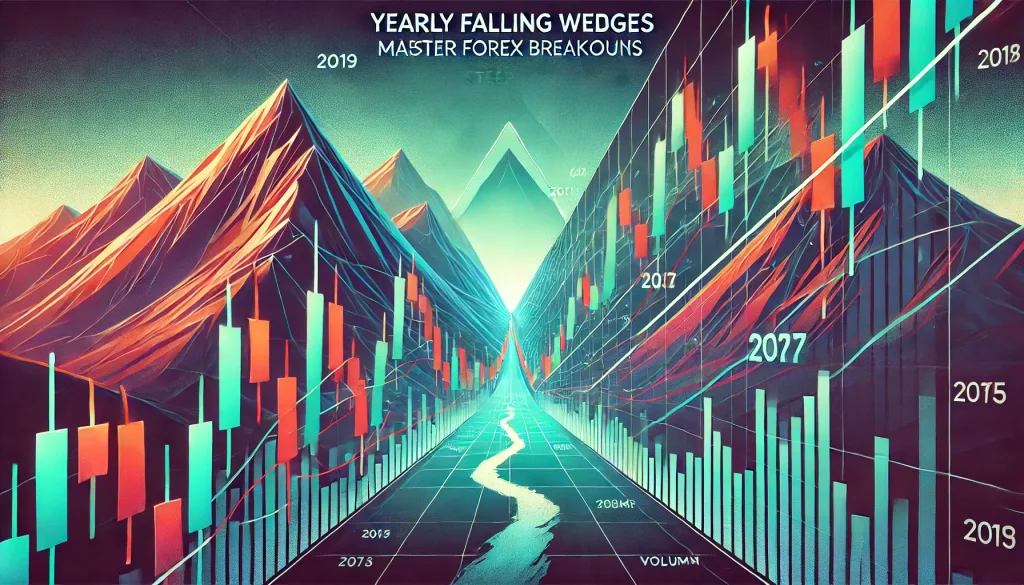Yearly Falling Wedges: Master Forex Breakouts

Yearly Patterns and Falling Wedges: Cracking the Code for Forex Success
Picture this: You’re at a carnival trying to win a game of ring toss. The market, much like that game, can feel rigged at times. But what if you had insider tips to know exactly when and where to aim? Enter the yearly falling wedge pattern, the trading strategy that’ll make you feel like you’ve mastered the game.
In this article, we’ll unravel the yearly patterns hidden in falling wedges, dive into strategies for spotting them, and sprinkle in some humor (because trading should be fun, right?).
What Is a Falling Wedge, and Why Should You Care?
A falling wedge is like a coiled spring, compressing tighter and tighter before launching upward. It’s a bullish reversal pattern that signals potential breakouts. When spotted on yearly charts, these patterns can indicate significant long-term opportunities.
Key Characteristics of a Falling Wedge:
- Sloping Trendlines: Both upper and lower trendlines slope downward, with the upper line converging faster.
- Decreasing Volume: Volume typically drops as the wedge forms, hinting at a brewing breakout.
- Breakout Confirmation: The price breaks above the upper trendline, often with a spike in volume.
Think of it like watching your favorite TV show—the buildup is slow, but the season finale? Explosive.
Yearly Patterns: The Hidden Gems of the Forex Market
Yearly charts provide a bird’s-eye view of market trends. They smooth out short-term noise and reveal patterns most traders overlook.
Why Yearly Falling Wedges Matter:
- Long-Term Trends: They highlight significant shifts in market sentiment.
- High Reward Potential: Breakouts from yearly wedges often lead to sustained bullish trends.
- Fewer False Signals: Yearly charts reduce the risk of chasing fake breakouts.
The Ninja Tactics: Spotting and Trading Yearly Falling Wedges
Here’s how to turn yearly falling wedges into profit machines:
1. The Magnifying Glass Method
Zoom out to yearly charts and look for converging downward trendlines. Use tools like Fibonacci retracements to measure potential breakout targets.
- Bonus Hack: Overlay the RSI indicator. If RSI forms a bullish divergence, it’s a double confirmation.
2. Volume Spy
Monitor volume levels as the wedge forms. Decreasing volume suggests a breakout is near, while a volume spike on the breakout confirms it.
- Bonus Hack: Use TWAP (Time-Weighted Average Price) to fine-tune your entry during the breakout.
3. The Patience Play
Yearly wedges require—you guessed it—patience. Set alerts at key levels to avoid staring at charts endlessly.
- Bonus Hack: Combine the falling wedge with macroeconomic analysis. A dovish central bank announcement could align perfectly with the breakout.
Case Study: EUR/USD’s Yearly Falling Wedge
In 2022, EUR/USD formed a textbook falling wedge on its yearly chart. Volume declined steadily, and RSI hinted at bullish divergence. When the breakout occurred, the pair rallied over 800 pips in six months.
Takeaways from the Case Study:
- Use multiple indicators to confirm the pattern.
- Align your trades with fundamental catalysts.
- Scale into your position during the breakout for better risk management.
Common Pitfalls (And How to Avoid Them)
Mistake #1: Misidentifying the Pattern
Not every wedge is a falling wedge. A descending triangle, for instance, is bearish.
- Fix: Ensure both trendlines slope downward and converge.
Mistake #2: Ignoring Volume
Breakouts without volume confirmation are often fake.
- Fix: Wait for a clear volume spike before entering a trade.
Mistake #3: Chasing the Breakout
Entering late can lead to suboptimal entries and higher risk.
- Fix: Anticipate the breakout and place limit orders near the upper trendline.
Final Thoughts: Yearly Falling Wedges as Your Secret Weapon
Yearly falling wedges aren’t just patterns—they’re opportunities to ride long-term trends with confidence. By combining technical analysis, volume monitoring, and macroeconomic insights, you can turn these patterns into consistent profits.
—————–
Image Credits: Cover image at the top is AI-generated
PLEASE NOTE: This is not trading advice. It is educational content. Markets are influenced by numerous factors, and their reactions can vary each time.

Anne Durrell & Mo
About the Author
Anne Durrell (aka Anne Abouzeid), a former teacher, has a unique talent for transforming complex Forex concepts into something easy, accessible, and even fun. With a blend of humor and in-depth market insight, Anne makes learning about Forex both enlightening and entertaining. She began her trading journey alongside her husband, Mohamed Abouzeid, and they have now been trading full-time for over 12 years.
Anne loves writing and sharing her expertise. For those new to trading, she provides a variety of free forex courses on StarseedFX. If you enjoy the content and want to support her work, consider joining The StarseedFX Community, where you will get daily market insights and trading alerts.
Share This Articles
Recent Articles
The GBP/NZD Magic Trick: How Genetic Algorithms Can Transform Your Forex Strategy
The British Pound-New Zealand Dollar: Genetic Algorithms and the Hidden Forces Shaping Currency Pairs
Chande Momentum Oscillator Hack for AUD/JPY
The Forgotten Momentum Trick That’s Quietly Dominating AUD/JPY Why Most Traders Miss the Signal
Bearish Market Hack HFT Firms Hope You’ll Never Learn
The One Bearish Market Hack High Frequency Traders Don't Want You to Know The

